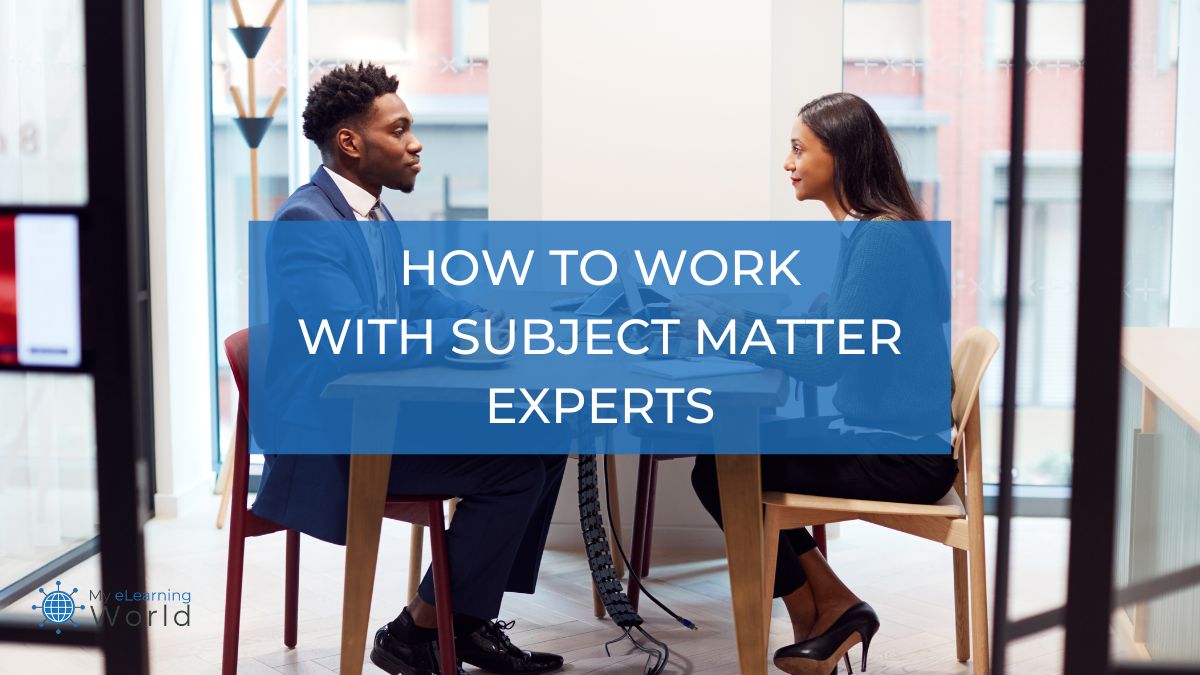You just got an instructional design job but you know nothing about the topic you are tasked to build a course about. Don’t panic! That’s why it’s such a benefit to work with a subject matter expert (SME). While you are a pro at designing and developing an engaging course, your SME is a pro at sharing the specific content you will need to make that happen!
Working with an SME is a great way to get the inside scoop and most reliable information when working on an instructional design project. This subject matter expert is a person who specializes in their field and is able to provide insight and information to an instructional designer as they develop content and curriculum. They are the go to person for you to seek out when you have questions, need clarity, or get stuck with the content or information.
In my experience, the SME is often the direct contact for an instructional designer. It’s important for me to have a contact who I can reach out to with questions during the design process. While I appreciate the guidance of an SME, it’s important to note that they have responsibilities to help designers understand the information, but it’s the designer’s role to gather materials and actually design the coursework.
Best Practices to Implement When Engaging SMEs
Implementing these best practices is a great way to ensure success when working with subject matter experts.
- Readiness is key. Be sure that you value and appreciate your SME’s time. By thinking through the project and preparing a list of notes and questions, you can be respectful and productive in the time given to you to meet with your SME. Research ahead of time to learn more about the company. Try to immerse yourself in understanding their background, goals, and mission. As I am designing a project, I try to keep the end goal in mind and always prefer to work by backwards design. This is a great method for helping to stay organized and be prepared.
- Punctuality matters. SMEs are often very busy with other responsibilities as well. Be sure that you are on time and that you stay focused on the project so you make the best use of your time and the time of your SME. Honor your SME’s time by sticking to timeframes and not running over the set meeting times.
- Gain clarity. Be clear about your role and what you need from your SME. Communicate clearly and reiterate expectations to be sure you are on the same page. Try to be specific with your questions and explanations. Be sure that you and your SME understand how each other prefers to work and communicate. Ask them to be very specific and provide information in the simplest form.
- Set deadlines and schedule time to meet with your SME. Sometimes they have limited time but be clear about the value of regular check-ins to help ensure everyone is making the best use of time as the course is built and time spent revising is lessened.
- Keep a productive mindset. Practice active listening and take good notes. It may even be a good idea to record the conversations so you can go back and review. I like to record my interviews and meetings so if I have questions, I can go back and listen again to see if I can find my own answer before having to reach out to my SME again.
- Remember that your SME is investing time and effort into this project as well. Be sure to include your SME when sharing results and data or asking for feedback. This helps your SME stay connected and involved, even if you don’t have to reach out for additional meetings or need information from them.
Steer Clear of These Practices
Sometimes best practices can be found in what not to do. There are also some things you want to avoid when working with an SME. In order to maintain professionalism, be sure that you know proper expectations and observe best practices when working with an SME. Remembering these things and putting them into practice will help others build confidence in you and improve your soft skills as an instructional designer.
- Working with an SME, you should understand that while they can provide many answers to questions, it’s beyond their role and responsibility to gather materials and provide resources for you. Instead, think of them as your guide to find the information you need and direct you where to find your own resources and materials.
- Don’t expect your SME to change the way they do things to fit your mold. Being flexible is a big part of being an instructional designer. In my experience, I find it challenging, in a good way, to learn and use new technology. In addition to building my knowledge base and how to use new apps or platforms, sometimes I am even able to find ways to build my own productivity.
- Understand that your time table may not be the same as your SMEs. Don’t expect them to be able to respond immediately to your questions. Remember that as instructional designers, we can work on many facets of the design simultaneously. If you are awaiting an answer or feedback from your SME, busy yourself with other relevant tasks in preparation for the next phase of development.
- Don’t be afraid to ask questions! Be thoughtful and prepare meaningful and helpful questions and have a purpose behind your meetings with your SME. Make the best use of time with them and be sure to communicate what you will need from them moving forward.
Collaboration is a Top Priority
Collaborating with an SME is a huge benefit to instructional designers. Throughout the process of designing and developing courses, collaboration is a key foundational component to finding success in your project. In order to be a productive collaborator, it’s important to remember some norms that will help guide you in achieving your goals for this project. You should work with your team to develop the norms that everyone values.
- While active listening is extremely important, so is follow up. Summarize what your SME has shared with you and ask questions to get clarification if needed. Be sure to ask if your SME has questions as well. This will help them understand the project and what your role is, which will help them to be able to better help you.
- Define roles in a detailed way. In my experience, this is often done at the start of a project by the project manager. When everyone understands the roles of everyone else on the team, it makes it easier to communicate and understand how you can help your teammates.
- Reflection is a vital piece of the puzzle for projects. It’s often overlooked and undervalued, sometimes even forgotten. While we are so busy gathering and analyzing data to ensure our client’s goals are met, we often forget to take the time to reflect upon ourselves and our own practices. Ask yourself if you or the team could have done things differently to gain better results faster. Reflecting together is a valuable experience as well, but it will only work in a safe and open environment.
Final Thoughts
Next steps for a project will always include your SME, especially in fields that you aren’t familiar with. Remember that collaborating with an SME can be an extremely beneficial learning process for you and for them. While they are helping you understand the specific content needed, you are educating them on the way the world of instructional design and development works. As more SMEs work with us, they will continue to gain respect and appreciation for what we can bring to the table. While the world of instructional design and development is not new at all, many people are not familiar with it and what it entails.
On occasion, you may run into an SME who is difficult to work with or doesn’t value our work as instructional designers. Don’t fret! You can make efforts to understand why it’s difficult to work with the SME. Do they have a specific concern? Perhaps they don’t understand what your role entails? Be patient and professional. Stay positive and encourage open communication and collaboration. Remember that part of your skillset as an instructional designer includes a set of soft skills as well.
Overall, you will see many benefits of working with an SME to gain success in your goals and the goals of your client. Your role can be impacted in a positive way if you take advantage of all your SME has to offer. Try to build a rapport early on to set up success for the long term.
More Helpful Resources for Instructional Designers
- How to become an instructional designer
- How to create an instructional design resume
- How to write an instructional design cover letter
- Instructional designer salary guide
- Instructional design portfolio examples & tips
- The most common instructional design interview questions
- The best instructional design courses online
- The best instructional design bootcamps
- Instructional design master’s programs
- Instructional design career path & responsibilities



